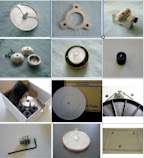For a belt-drive turntable, the pulley may be just a small part, but it plays a crucial role in transferring energy from the motor to the platter and this directly affects the performance of the TT. Knowing this fact, many Rega TT owners have ungraded the stock plastic/aluminium pulley to either standard (33.3/45rpm) stainless steel pulley or dual (33.3/33.3rpm) pulley and enjoyed significant sonic improvement with the upgrade.
Charles Hansen of USA, a university professor in music has a P25 TT with Music Hall Cruise Control 2.0 power supply. He was interested in this pulley upgrade. But 33.3/33.3rpm dual pulley was not compatible as Cruise Control required the belt to be parked at 45rpm(pulley groove). He had no choice but to go for the standard pulley first and requested for a 45/45rpm dual pulley specially for his Cruise Control.
After trying out the 45/45rpm stainless steel pulley, what he has to say.....?
He suggests all P25 owners to go for this option!
Here's Charles Hansen's comment on after upgrading to 45/45rpm double pulley, silicone belts and aluminium feet:
Dear Michael,
The custom pulley and feet arrived safe and sound a couple of weeks ago and, just this past Saturday I had the time and quiet to install the whole bit. The pulley fit beautifully and I didn't have to adjust the motor spacers I had put in there previously to accommodate the first pulley you sent me. The new feet went on easily and, finally, I was able to install the two silicone belts you sent on the previous order. I probably should have installed the pulley and the double belts, gotten used to the sound and then, installed the feet but, I was not so patient! Tonight I am listening to Mozart piano sonatas and it is simply magnificent! My P25 is such a different animal than it was only a few weeks ago. The addition of your metal double pulley along with the Music Hall speed control really has solidified the imaging between my loudspeakers. I also feel as though I have gained almost an octave of bass response. Additionally, the timbal quality of the the instruments has somehow been enhanced in that I can hear the harmonics associated with the individual sounds as never before.The bass range of piano recordings is so much clearer, deeper and focused now. When listening to the Stravinsky Symphony in C, I was shocked by the double basses. For the first time, I heard the the harmonics within their sound – something I have NEVER heard before on what is a rather familiar recording. It's like they are really there and they don't get just "mushed" into the sound. For the first time in my years with the P25, instruments retain their individual qualities and location and have what I suspect is "air" around them. In my real life I am a university professor of music and a professional bassoonist playing over 60 concerts a year. I have played in orchestras for over 30 years and am very familiar with how instruments sound in real life.The upgrades to my P25 have brought me as close to that sound that I know as I've ever heard from my system. I would suggest that, for owners of the P25, using your double 45/45 rpm pulley in combination with the Music Hall Cruise Control 2.0 is really the way to go. Easy instalation and not so expensive. Years ago, I bought an Iorn Audio acrylic platter to replace the glass/felt combination on my P25. That was a probably a "minor" upgrade. A year or so ago, I bought a reference subplatter from GrooveTracer and a white Rega belt. That added a good measure of clarity to the sound. However, it wasn't until I added the Music Hall Cruise Control 2.0, your custom double pulley, aluminum feet and silicone belts to the mix that everything really came together for me. Just brilliant! My congratulations to you for such fantastic engineering and design work and the machining skill to bring these designs to life. I really appreciate your willingness to make that custom pulley for me. I'm so glad that I found out about your products! They have changed my analog life for sure. I will spend the coming months getting to know my 4,500+ collection of lps all over again. Kindest Regards, Charles Hansen |
Hi Michael,
This is a photo of your custom double 45rpm pulley installed on my Rega P25: |
As you can see, your pulley and double silicone belts both fit beautifully with my GT Reference subplatter.
In the next photo, I've set your standard 33/45 rpm pulley next to the installed 45/45 rpm pulley for comparison.
|
Here is a shot of the new aluminum feet. They look beautiful and, along with the other modifications, really enhance the sound.
You can also just see the Iron Audio acrylic platter I got years ago. I don't believe that company exists anymore…
|
The next photo shows my system with the Music Hall Crusie Control 2.0 (little box with green numbers) sitting on top of my Progressive Engineering phono preamp.
Also in the photo is my Wyred4Sound DAC2, Warpspeed LDR volume control and classDaudio SDS-450 monoblocks.
|
Below, is the setup I'm using to dial in the correct turntable speed. It's the Dr. Feickert system with the 7" test record and IPhone app to measure the 3.15kHz tone on the record.
You just press the + or – buttons on the front of Music Hall Crusie Control 2.0 and the speed is shown on your phone. The only inexpensive way I was able to find that accounts for stylus drag when adjusting turtable speed.
Totally easy to use and right on the money. |
It's true, I have a lot of lps… This is a shot of half of my collection the other half is on a different set of shelves in another room. Maybe one day I can have them all in the same place.
Again, thank you Michael for your terrific work and thoughtful engineering.
Cheers,
Chuck Hansen
|
An additional advantage of using the Cruise Control power supply is the speed of your TT can be fine tuned (not just selection of 33 or 45rpm only). Besides, as I have mentioned in my earlier post, when the belt is parked at 45(pulley groove)with this external power supply, the motor runs slower for 33 play-back, thus reducing motor noise and vibration. Significant sonic improvement can be expected.






























